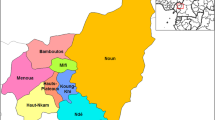Abstract
L-Cystine-amended H2S strip test was compared with conventional multiple tube fermentation tests for detecting faecal pollution in 200 drinking water samples drawn from different water sources. Of these, 134 samples were positive for total coliforms (TC), whereas the cystine-amended H2S test was positive with 116 samples. Faecal coliforms were present in 99 samples. Seventy-seven samples were also tested with presence–absence (P–A) strip test. By taking only the colour change (acid production) as positive indication for the presence of coliforms, 12 (47%) out of 26 water samples were graded as polluted in the absence of detectable coliforms. This indicated the critical importance of observing P–A bottle for gas production along with the colour. This aspect is important when commercially available P–A bottles are used in rural areas by unskilled personnel. Among different unpiped water sources tested, 94% samples drawn from India Mark II hand-pumps had TC counts within WHO guidelines.
Similar content being viewed by others
References
Alonso, J.L., Soriano, A., Carbojo, O., Amoros, I. & Garelick, H. 1999 Comparison and recovery of Escherichia coli and thermo-tolerant coliforms in water with a chromogenic medium incubated at 41 and 44.5 °C, Applied and Environmental Microbiology 65, 3746–3749.
APHA 1989 Standard Methods for the Examination of Water and Wastewater Analysis 17th edn. Washington, DC: AWWA, and WPCF (Jointly published) ISBN 0-87553161-X.
Barrett, E.L. & Clark, M.A. 1987 Tetrathionate reduction and production of hydrogen sulfide from thiosulfate. Microbiological Reviews 51, 192–201.
Bancroft, K.B., Nelson, E.T. & Childers, G.W. 1989 Comparison of the presence-absence and membrane filtration techniques for coliforms detection in small non-chlorinated water distribution systems. Applied and Environmental Microbiology 55, 507–510.
Castillo, G. et al. 1994 Evaluation of disinfected and untreated drinking water supplies in Chile by the H2S paper strip test. Water Research 28, 1765–1770.
Clark, J.A. 1968 A presence-absence (P-A) test providing sensitive and inexpensive detection of coliforms, faecal coliforms and faecal Streptococci in municipal drinking water supplies. Canadian Journal of Microbiology 14, 13–18.
Clark, J.A., Burger, L.A. & Sabatinos, L.E. 1982 Characterisation of indicator bacteria in municipal raw water, drinking water and new main water supplies. Canadian Journal of Microbiology 28, 1002–1013.
Clark, J.A. & El-Shaarawi, A.H. 1993 Evaluation of commercial presence-absence test kits for detection of total coliforms, Escherchia coli and other indicator bacteria. Applied and Environmental Microbiology 59, 380–388.
Edberg, S.C., Allen, M.J. & Smith, D.B. and The National Collaborative Study 1988 National field evaluation of a defined substrate method for the simultaneous enumeration of total coliforms and Escherichia coli from drinking water: comparison with the standard multiple tube fermentation method. Applied and Environmental Microbiology 54, 1595–1601.
Edberg, S.C., Allen, M.J., Smith, D.B. and The National Collaborative Study 1989 National field evaluation of a defined substrate method for the simultaneous detection of total coliforms and Escherchia coli from drinking water Comparison with presence-absence techniques. Applied and Environmental Microbiology 55, 1003–1008.
Fliess, J.J. 1981 Statistical Methods for rates and Proportions pp. 212–236, John Wiley and Sons, New York ISBN: 0-471-06428-9.
Gordon, F.D. 2000 National Intelligence Estimate: The Global Infectious Disease threat and its implications for United States. National Intelligence Council. 33–65. (http://ecsp.si.edu/pdf/Report6-3.pdf)
Grant, M.A. & Ziel, C.A. 1996 Evaluation of a simple screening test for faecal pollution. Journal of Water SRT Aqua 45, 13–18.
Hubner, I., Steinmetz, I., Obst, U., Gielbel, D. & Bitter-Suermann, D. 1992 Rapid determination of members of the family Enterobacteriaceace in drinking water by an immunological assay using a monoclonal antibody against Enterobacterial common antigen. Applied and Environmental Microbiology 58, 3187–3191.
Jacobs, N.J., Zeibler, W.L., Reed, F.C., Stukel, T.A. & Rice, E.W. 1986 Comparison of membrane filter multiple fermentation-tube and presence-absence techniques for detecting total coliforms in small community water system. Applied and Environmental Microbiology 51, 1007–1012.
Manja, K.S., Maurya, M.S. & Rao, K.M. 1982 A simple test for the detection of faecal pollution in drinking water. Bulletin WHO 60, 797–801.
Pipes, W.O., Minnigh, H.A., Moyer, B. & Troy, M.A. 1986 Comparison of Clark 's presence-absence test and membrane filter method for coliform detection in potable water samples. Applied and Environmental Microbiology 52, 439–443.
Pillai, J., Gibbs, K., Mathew, K. & Ho, G.E. 1997 Bacteriological water testing by H2S method. In Proceedings of 23rd Water, Engineering and Development Centre Conference. eds. Edited by John Pickford, 289–292.
Ratto, A., Dutka, B.J., Vega, C., Lopez, C. & El-Shaarawani, A.H. 1989 Potable water safety assessed by coliphage and bacterial tests. Water Research 23, 253–255.
Ramteke, P.W. 1995 Comparison of standard most probable number method with three alternate tests for detection of bacteriological water quality detectors, Environmental Toxicology and Water Quality 10, 173–178.
Smith, H.G. 1959 On the nature of the selective action of selenite broth. J.Gen.Microbiol 21, 61–71.
Venkobachar, C., Kumar, D., Talreja, K. & Iyengar, L. 1994 Assessment of bacteriological water quality using a modified H2S strip test. Journal of Water SRT Aqua 43, 311–314.
World Health Organization, 1984 Guidelines for drinking water, 1st edn. ISBN 92-4154168-7.
World Health Organization, 1993 Guidelines for drinking water, 2nd edn. ISBN 92-4154460-0.
Author information
Authors and Affiliations
Rights and permissions
About this article
Cite this article
Pant, H., Sarfaraz, S. & Iyengar, L. Evaluation of L-Cystine-amended H2S test for the detection of faecal pollution in potable water: comparison with standard multiple tube fermentation method. World Journal of Microbiology and Biotechnology 18, 321–324 (2002). https://doi.org/10.1023/A:1015253030573
Issue Date:
DOI: https://doi.org/10.1023/A:1015253030573



